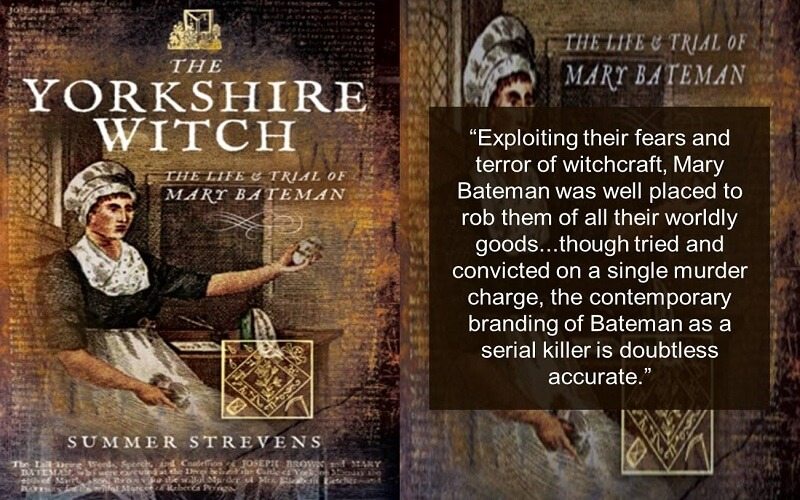“Meticulously researched, this accessible, and at times shocking retelling of Mary Bateman’s life, and indeed her death, is the first since the publication chronicling her criminal career appeared in print in 1811, two years after her execution.”
Within British true crime history, the name Mary Bateman is one that stands out. Known as the ‘Yorkshire Witch’ she was a woman who used her charm, intelligence, and deviousness to fleece her unsuspecting victims out of their belongings and their money. Whatsmore, she preyed on the vulnerable, exploiting their fears and their beliefs surrounding witchcraft to her advantage. She was a ruthless individual whose focus was on achieving what she wanted regardless of the damage she left in her wake, and once she became confident, her scheming and deceit reached a new level, one which strayed into the realms of murder.
Mary Bateman was hanged on 20 March 1809 in York’s New Drop Gallows before a vast crowd of onlookers just three days after her conviction for murder. By the time of her execution the public was looking forward to watching a woman they believed was a scheming witch be put to death for her crimes, and they had a curiosity as to whether this witch could get herself out of the gruesome predicament she now found herself in.
“Certainly the allusion to witchcraft darkly tinged Mary’s name. As evidenced by those amongst the crowd gathered to witness her execution, believed to the very end that ‘the Yorkshire Witch’ would save herself from death at the last moment by employing her supernatural powers to vanish into thin air as the noose tightened…”.
In the late 18th century, a belief in witchcraft was still common across the country and it was a belief Mary Bateman quickly realized she could exploit. She claimed to be a clairvoyant and able to speak to the dead using her abilities to save people from evil spirits, cast spells, and cure ailments. All of which was a con.
Mary had a history of causing trouble from the time her parents placed her with a family in the town of Thirsk in North Yorkshire where she worked as a maid to try and mend her ways, to the many houses she was asked to leave over the following years. In 1787 she relocated to York where after her thefts from her employers were discovered she was dismissed again and returned to her hometown of Leeds.
She learned early in her life that she could be manipulative and deceptive while remaining believable and convincing, skills when applied correctly she thought, could net her a great deal of money and goods for little work on her part.
Summer Strevens is a historical research writer who has written a number of books on historical true crime. Her latest title The Yorkshire Witch: The Life & Trial of Mary Bateman is a comprehensive look at this historical figure and the first book to define and characterize the life of Mary Bateman from her early beginnings through her criminal career and to her execution since the publication of her life first appeared in print in 1811, two years after she was executed.
It is a book that also examines the aftermath of Mary Bateman’s execution, the myths, and tales that have circulated about this so-called witch, and the display of her skeleton at the Thackray Medical Museum up until only recently, which many felt was immoral and unnecessary.
Split into ten chapters ‘The Yorkshire Witch’ gently carries you through the life of Mary Bateman. Sixteen pages of photos are also included grounding the narrative and providing a fascinating insight into the sights and surroundings key to this tale.
The story of Mary Bateman is a complex one with many twists and turns as her numerous frauds, thefts, and deceptions gradually lead her to murder. Summer Strevens is an experienced historian who has been able to bring this story back to life through engaging writing and insightful description. She has packed a great deal of information into this book, but it does not read as a heavily overloaded narrative. Instead, it is an enjoyable journey with the knowledge that what you are reading is based on research and facts giving you the real story of Mary Bateman as the Yorkshire Witch.
In places sentences are very long and slight deviations into historical information can take away from the tale, however, these are minor points that do not impact the enjoyability of this book.
Mary Bateman as the Yorkshire Witch
Marrying her husband John Bateman who she’d known only a few weeks on 26 February 1793, she soon proved that a life with Mary Bateman meant a life of constant moving to avoid the locals catching on to her scams and the authorities who would want her punished. Mary, always looking to expand on her scams, created a number of personas that she said she could ‘connect’ with and carry messages to.
“Whether John Bateman was either unaware or unwilling to acknowledge the truth, he cannot have failed to notice the pattern of accusations of theft that appeared to dog his wife.”
These included ‘Miss Blythe’, a woman who could read the stars and fully predict the future who worked through Mary Bateman, and ‘Mrs Moore’ who could provide a ‘screwer-down’ service with Mary as her agent.
Mary Bateman would persuade or encourage a person to believe that someone wanted to harm them and that someone could be stopped if they were ‘screwed-down’. If creditors were chasing for money or a husband was cheating on his wife they could be dealt with and the threat eliminated, for a price of course.
Her descent into murder first came when she targeted two Quaker sisters, the Kitchins. Living with their mother above the draper’s shop they owned, Mary made herself comfortable by working in the shop for them and becoming their friend and confidant. As usual, these unsuspecting women were charmed by Mary Bateman and despite their Quaker belief Mary managed to con them just as she did everyone else. When one sister fell ill, the dutiful Mary offered to nurse her through her illness, an illness that may very well have been caused by Mary herself.
Using her alter ego Miss Blythe, Mary sourced medicines for the Kitchin sister, medicines unbeknown to them which were laced with poison. She died and within weeks her remaining sister and her mother became ill with the same symptoms and they too succumbed to the terrible illness which Mary Bateman told everyone who asked was the plague. An explanation that served to scare anyone off from investigating the deaths through fear of being infected themselves. One sharp-eyed doctor did raise his suspicions of poisoning, but with no family member left to provide consent to an autopsy, his concerns went unheard and uninvestigated.
Under the cover of the plague infecting the house and shop, Mary stripped both bare ensuring she received maximum profit for her efforts. Soon after, Mary and her husband moved again distancing themselves from any connection to the Kitchin sisters and their deaths.
The Murder of Rebecca Perigo
The murder in which Mary Bateman would be convicted and hanged was that of Rebecca Perigo, a woman with mild health complaints but with psychological issues and a belief she was being haunted by spirits and a black dog. Mary was suggested as someone who could remove the spirits from her and make her well again, a suggestion that resulted in her untimely death. Using her previously successful Miss Blythe ruse, Mary gave the Perigo’s instructions in a series of letters which they were to burn as soon as those instructions had been carried out, conveniently destroying any evidence against Mary Bateman in the process.
Various items from linen to silverware and cash were requested by Mary that had to be sent to Miss Blythe in return for her help. Next came the medicines that had been made up specially by Miss Blythe to be taken by Rebecca Perigo and finally puddings that should be made with a special powder that should only be eaten by William and Rebecca Perigo. The couple complied with all of Mary Bateman’s instructions to the letter including not calling a doctor when Rebecca became ill.
Rebecca Perigo died prompting her husband to seek medical advice and this medical opinion raised the question of poisoning. Mary Bateman was arrested when William arranged a meeting with her and took along a police officer. When a search of her home in October 1808 highlighted all the items supposedly sent onto Miss Blythe were in fact with Mary Bateman, she was charged with fraud and found herself under investigation for murder. Two months later she was charged with the murder of Rebecca Perigo and sent to York Castle Gaol to await trial.
A psychological disorder?
A rather interesting discussion in the final chapter of ‘The Yorkshire Witch’ looks closely at the behavior of Mary Bateman against the characteristics and traits of antisocial personality disorder considering whether Bateman could be regarded as a psychopath or sociopath.
This is followed by an exploration of how Mary Bateman’s remains were treated after her death, the exploitation in many ways of her skeleton in order to cash in on her notoriety. The decision to hang her skeleton on display inside Thackray Medical Museum until mid-2015 has caused some controversy, although this didn’t stop the tourists flocking in to see it for themselves.
The Yorkshire Witch is more than a book telling the criminal life of Mary Bateman; it provides an insight into the historical times she operated in and how these provided her with more opportunities to carry out her wicked scams. It also assesses who Mary Bateman was, her personality, and her behavior and applies more advanced knowledge to aid an understanding of her operations and her frame of mind. For an in-depth exploration of the character of Mary Bateman, the historical era she lived in and exploited alongside a detailed examination of her crimes, this book will not leave you disappointed.
You can purchase a copy of ‘The Yorkshire Witch: The Life & Trial of Mary Bateman‘ by Summer Strevens at Pen & Sword Books.



